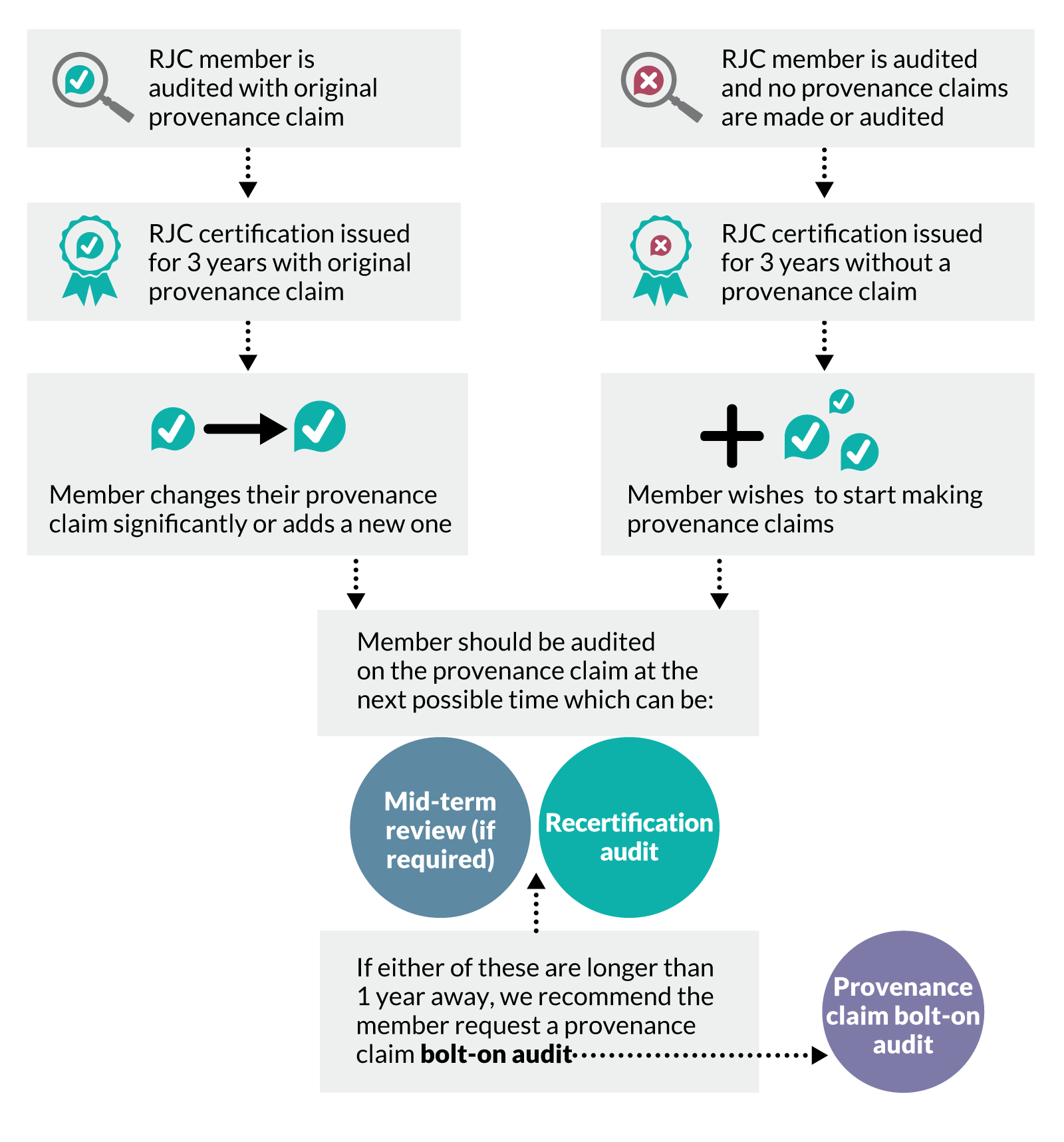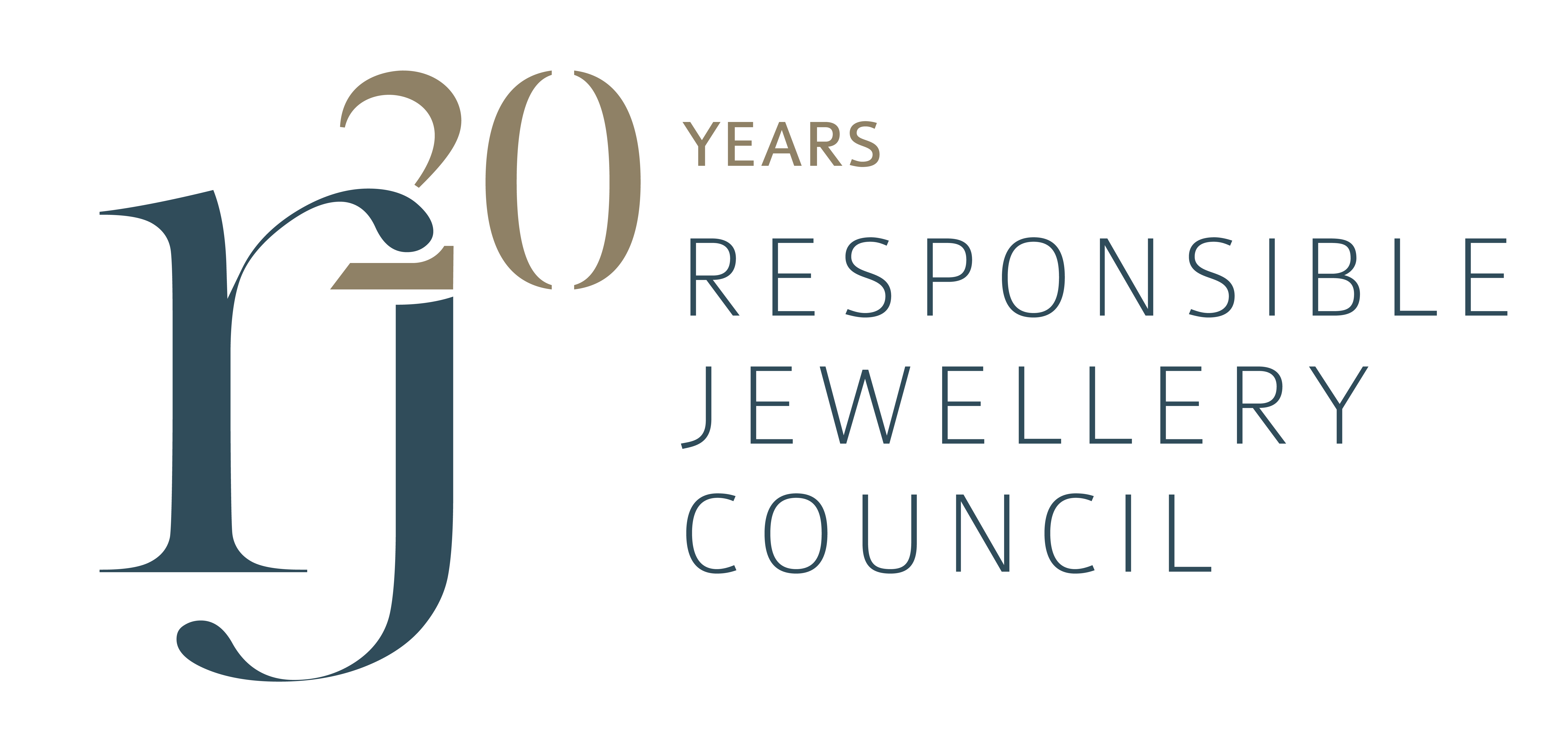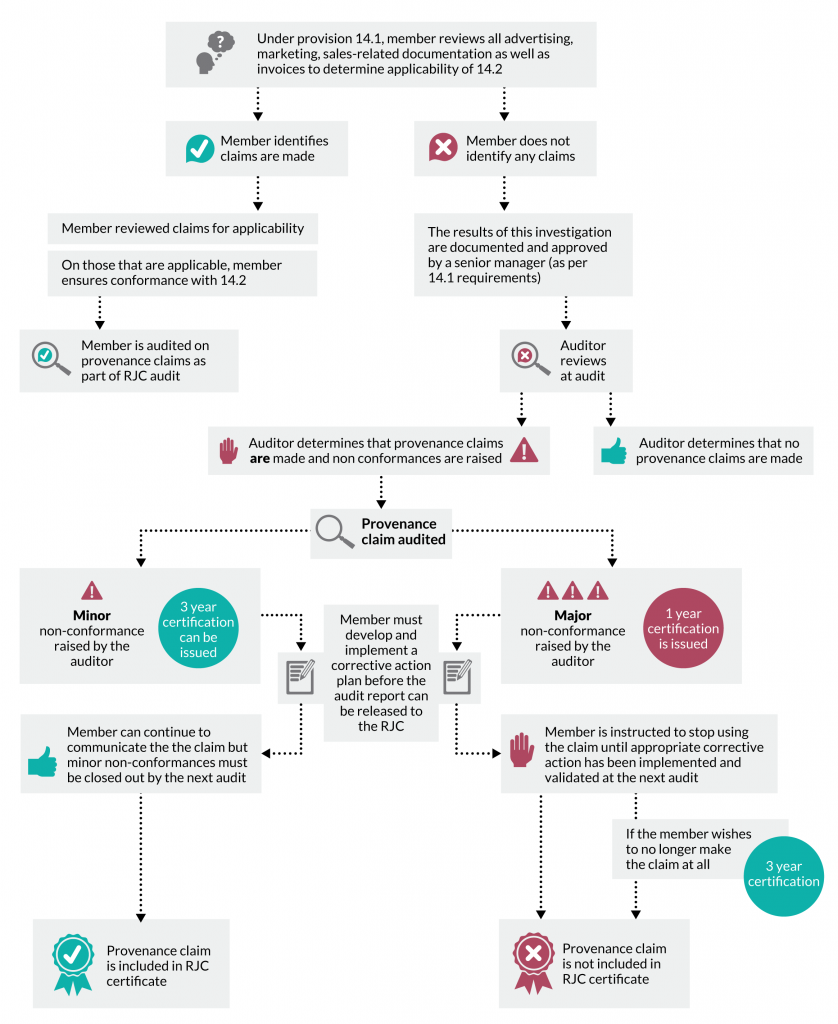cop 2019 provision 14
Provenance claims
This provision allows members that make claims about the provenance of materials (source, origin or practices used when sourcing), to have these audited as part of their RJC COP audit.
Requirements
14. Provenance claims
14.1. Members shall check whether they make any provenance claims that apply under this provision.
14.2. Members that make one or more provenance claims shall:
- Have systems to ensure that the provenance claims are truthful and substantiated by evidence.
- Do training to ensure that employees who are responsible for implementing the claims and responding to product enquiries, understand the claims and can explain them accurately.
- Make further information available to customers who ask about a provenance claim.
- Have a complaints or grievance mechanism appropriate to the nature, scale and impact of the business to allow interested parties to voice concerns.
14.3. Members who sell directly to consumers must make available at the point of sale, and on their website, further detail about the claim/s being made, and the systems in place to achieve them.
FAQs
These are claims made by RJC members about the way they source their materials, or what kind of material they can provide to customers. They can take many different forms depending on how a business operates, and what commitment it wants to make. We’ve identified four main, but not exhaustive or mutually exclusive, scenarios for making provenance claims. These are when a member:
- traces material back through the supply chain to its origin, for example through invoices from the mine of origin. This can be done using systems such as Canadamark, or through systems using new technologies like blockchain;
- or if a member verifies the sources or practices of material, for example working with suppliers to source recycled material or material from cyanide-free mining;
- or if a member sources material from certified suppliers or buys certified material, for example buying Fairmined or Fairtrade gold;
- or, when a member scrutinises materials or sourcing in another way, for example going beyond due diligence requirements for responsible sourcing from conflict-affected and high-risk areas (covered under COP 7) and carrying out due diligence on environmental impacts related to mineral production.
If you have a provenance claim audited as part of your RJC audit, the claim will be included on your certificate which appears on your RJC webpage:
No, members are not obliged to make claims. However, all members are required to check whether they make provenance claims (2019 COP requirement 14.1).
We advise members to review advertising, marketing and other sales-related documentation to determine whether any provenance claims are made. Here’s an example which may not be written, but is telling your customers you will sell them diamonds from Canada:
Don’t forget to look at invoices to check if any statements that could be considered a provenance claim are included on these.
If you do make a claim, this must be audited as part of your RJC audit. You can also add on a provenance claim as a ‘bolt-on’ to your RJC certification through a mid-term review audit, or a specific provenance claim bolt-on audit. Please see the section ‘I want to start making a claim but I’m already certified‘ below for more information. If you do make provenance claims, you must include this when completing your self-assessment, and you must highlight this to your audit firm so they can accommodate it into your audit.
Note that you can still make provenance claims even if they only apply to some, rather than all, of your materials. You need to make this clear in the claim. That means using qualifying phrases such as ‘when requested’, ‘we can offer…’ or ‘at least 95% of our diamonds are sourced from …’.
You can make a claim on any materials covered by the RJC standard you are being audited against.
For the 2019 COP these are gold, silver, platinum group metals (platinum and rhodium), coloured gemstones and diamonds.
Any other materials used in jewellery cannot be included in a provenance claim.
If you make a provenance claim, you must be able to substantiate it with an underpinning management system fit for the claim being made. The wording of the claim to be certified by RJC also needs to contain a clear ‘promise’ (part one) and explanation of how that promise can be achieved (part two).
- Material was/wasn’t mined in
- Country X;
- Region Y
- Material comes from a responsible mining company – you need to add how they’re responsible and the method of verification, for example they may be RJC certified or certified to another responsible standard. A mining company must be a legal entity
- Material is recycled
- Material has been responsibly mined by artisanal or small-scale operations
- Material is certified
- Mine of origin is certified
- Going beyond another COP provision – this must relate to sourcing
- Material is conflict-free – however please note, in these cases, the term conflict-free must be defined and further information made publicly available. Also conflict-free claims cannot be based purely on written assurances – this is already covered under COP 29
- Written assurances from suppliers – however this is not acceptable on its own for any conflict-free claims (as above)
- Invoices from mine of origin – please note it may not be possible for those buying from smaller producers of coloured stones to be assured of mine of origin through an invoice. Mines have to be legal entities
- Certification systems. These could be held by:
- The mining company
- A downstream company
- The member themselves
The certification could be a:
- Traceability system
- Blockchain system
- Gemmological laboratory assessment and report – Please note the laboratory’s system for assessing the determination must be made publicly available – this can be in summary form so as not to disclose intellectual property information This is important for when coloured stones are determined to be from a particular region or country by a gemological laboratory
- Due diligence approach that goes beyond requirements in COP 7
- Another other system or set of requirements that relate to responsible sourcing that is publicly available – these can be the members’ own systems and requirements, or external to the member
In most cases, yes. Provenance claims are an important provision that will need to be thoroughly audited if it’s applicable to your business. Depending on the number of audit days you will need to undergo more generally, as well as the provenance claim you’re making, a provenance claim could add half an audit day to your RJC audit. Please ask your chosen audit firm how a provenance claim will affect your RJC audit in terms of time.
If you make a provenance claim, you must be able to substantiate it with an underpinning management system fit for the claim being made. The wording of the claim to be certified by RJC also needs to contain a clear ‘promise’ and explanation of how that promise can be achieved. Your auditor will need to understand and verify how you ensure your claim is truthful, which is why they need evidence.
You will need to comply with and demonstrate through evidence how you meet all the requirements that are part of the provision:
14.2 Members that make one or more provenance claims shall:
- Have systems to ensure that the provenance claims are truthful and substantiated by evidence.
- Do training to ensure that employees who are responsible for implementing the claims and responding to product enquiries, understand the claims and can explain them accurately.
- Make further information available to customers who ask about a provenance claim.
- Have a complaints or grievance mechanism appropriate to the nature, scale and impact of the business to allow interested parties to voice concerns.
14.3: Members who sell directly to consumers must make available at the point of sale, and on their website, further detail about the claim/s being made, and the systems in place to achieve them.
Some examples of evidence your auditor may review for the provision include:
- Procedures – including identifying and documenting claims, ensuring they are valid – eg what requirements you make of your suppliers
- Records of documented criteria or requirements that you have – eg your definition of ‘responsible’ if that’s part of the claim you’re making
- Evidence that you are implementing controls to maintain the integrity of materials covered by your provenance claims – eg checking all sources
- Evidence that your staff are trained in provenance claims – eg training materials, attendance sheets or certificates
- A complaints or grievance mechanism and information on how to access it
- Records of complaints or grievances relating to your provenance claims
- Employee interviews – to check whether your employees understand how your system works in practice.
The auditing for COP 14 is designed to check that claims are truthful and substantiated by underpinning systems. There are various reasons why an auditor may raise a non-conformance against this provision. Below are some examples of both minor and major non-conformances for provenance claims.
If the audit uncovers a minor non-conformance, you will still be issued with a three-year certificate. You will however need to develop and implement a plan for addressing the non-conformance. The provenance claim will still appear on your RJC certificate.
Minor non-conformances will arise if, for example:
- The claim is based on written assurances from suppliers, a small number of sampled invoices (less than 10%) do not carry the provenance claim (assuming the claim covers all materials)
- You comply with all requirements of 14.2 except b (on training) or c (on a complaints mechanism)
- You were not using accurate wording when communicating your claim.
A major non-conformance means there is a risk your claim is not substantiated (which in turn carries a risk that your claim is not truthful). If there are indications that your systems are not working as they should, this could mean they are not strong enough. When a major non-conformance has been found, you will have to stop making the claim until the non-conformance has been addressed and a working system has been re-verified. This can mean a one-year RJC certification until the auditors can check the system again and once again, the provenance claim cannot appear on your RJC certificate, and you cannot make the claim anymore.
Major non-conformances will arise if, for example:
- If the claim is based on written assurances from suppliers, if more than 10% of sampled invoices do not carry the provenance claim (assuming the claim covers all materials) – the sample size may grow during the audit but the figure of 10% should stay fixed
- You had no systems in place to uphold your claim, or the auditor was not given enough evidence to verify adequate controls are in place.
- You didn’t recognise that you were making a provenance claim, and so hadn’t developed the necessary management systems to uphold it.
- The procedures underpinning your claim are systematically implemented in an inconsistent way.

Example Claims
Please note:We do not want to restrict members’ ability to summarise claims for marketing purposes, so while claims that are audited and certified by the RJC should include how they are implemented/verified, this does not mean that members must use the wording exactly as written on their certificate every time the claim is made or referred to.
“Based on written assurance from our suppliers, our diamonds have not originated from the Mbada and Marange regions of Zimbabwe”.
“We source all our gold responsibly from only LBMA Good delivery list refiners.”
“All our diamonds are sourced from Canada, as part of the CanadaMark program which tracks the diamonds from the mine of origin.”
These are some examples of statements that are not considered provenance claims, and so cannot be audited as part of the provision.
“All our diamonds comply with the Kimberley Process Certification Scheme and World Diamond Council System of Warranties.”
These requirements are covered under a separate provision ‘Kimberley Process Certification Scope and World Diamond Council System of Warranties, provision 29’ and so are not considered provenance claims.
“The diamonds herein invoiced have been purchased from legitimate sources not involved in funding conflict and in compliance with United Nations resolutions. The seller hereby guarantees that these diamonds are conflict free, based on personal knowledge and/or written guarantees provided by the supplier of these diamonds.”
These requirements are covered under a separate provision (Kimberley Process Certification Scope and World Diamond Council System of Warranties, provision 29) and so are not considered provenance claims. You can still include this statement on your invoices and it’s covered in your RJC audit, but under provision 29, and not as a provenance claim (provision 14).
“We test 100% of our diamonds and they’re natural” or “Based on written assurances from our suppliers, our diamonds are natural.”
Due to the 2019 COP requirements under Product Disclosure which cover actions to avoid buying and selling undisclosed synthetic diamonds (COP 28.3), 2019 audits cannot include claims about sourcing natural or synthetic-free diamonds.
“Our sapphires come from Kashmir.”
Due to the 2019 COP requirements under Product Disclosure which cover descriptions of place of origin for coloured gemstones (COP 28.2i), 2019 audits cannot include claims about the origin of coloured gemstones if this is based on opinion or observation, as place of origin is commonly used as a describer for characterising coloured stones and so information on place of origin should be treated as opinion, rather than fact. This includes testing by a gemmological laboratory, as this is still considered a matter of opinion. However, if a member who deals in coloured stones wishes to make claims about the region or country where the stones were mined, this may fall under the provenance claims provision if claims are based on a system to ensure region/country/mine of origin is known – for example if using a blockchain system.
“We source all our materials responsibly.”
By encouraging claims that refer to the systems behind them, we hope to discourage open-ended and vague claims which can be left open to interpretation. This additional information makes transparent how the member sources responsibly, and those who wish to source from them are clear what ‘responsible’ means.
“Our jewellery is made to the best quality on the market.”
This relates to product quality which is not covered by the provision which focuses on sourcing and provenance.
“Our watches are made in France.”
This relates to location of manufacture and not sourcing practices or systems.




